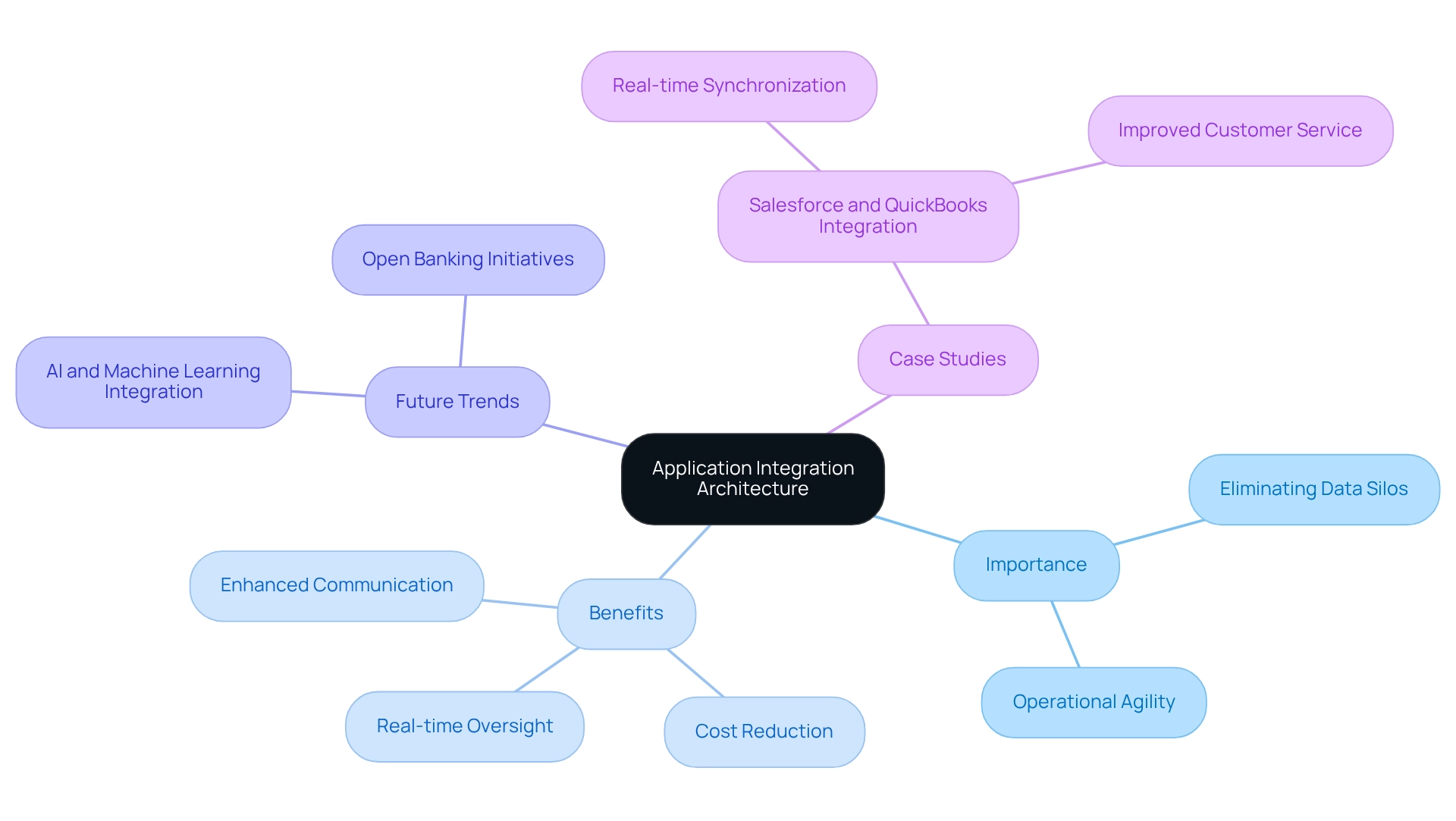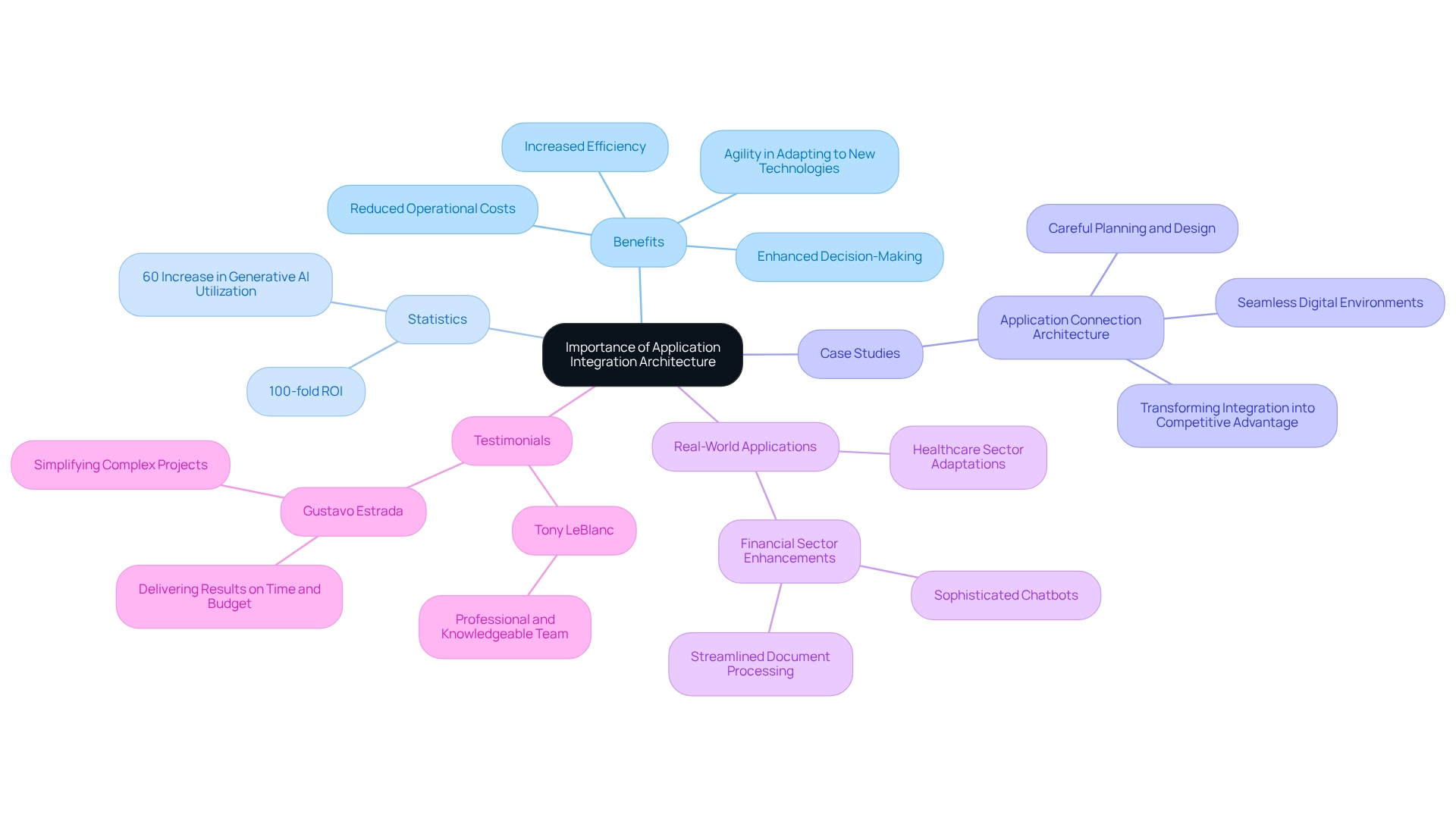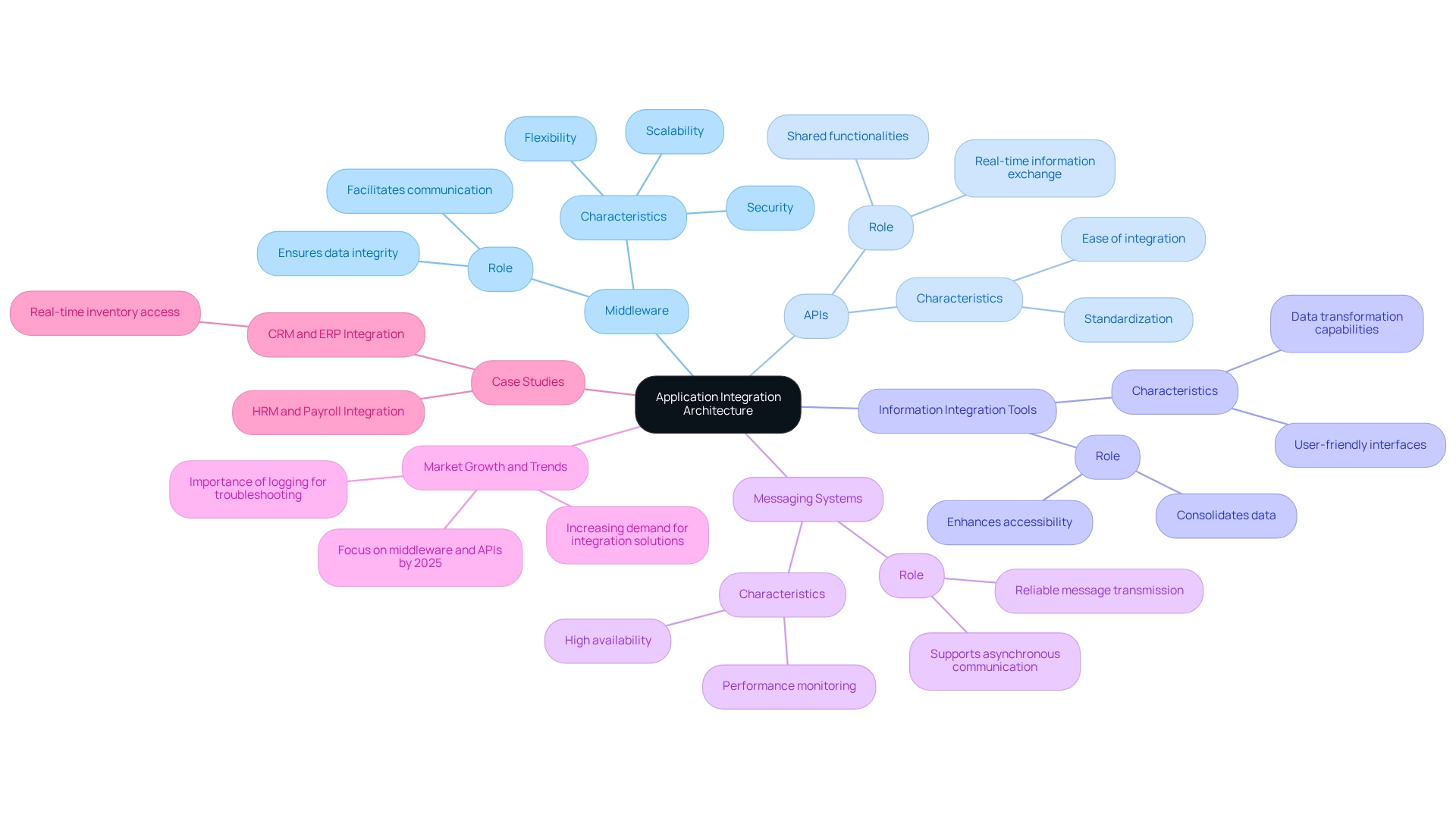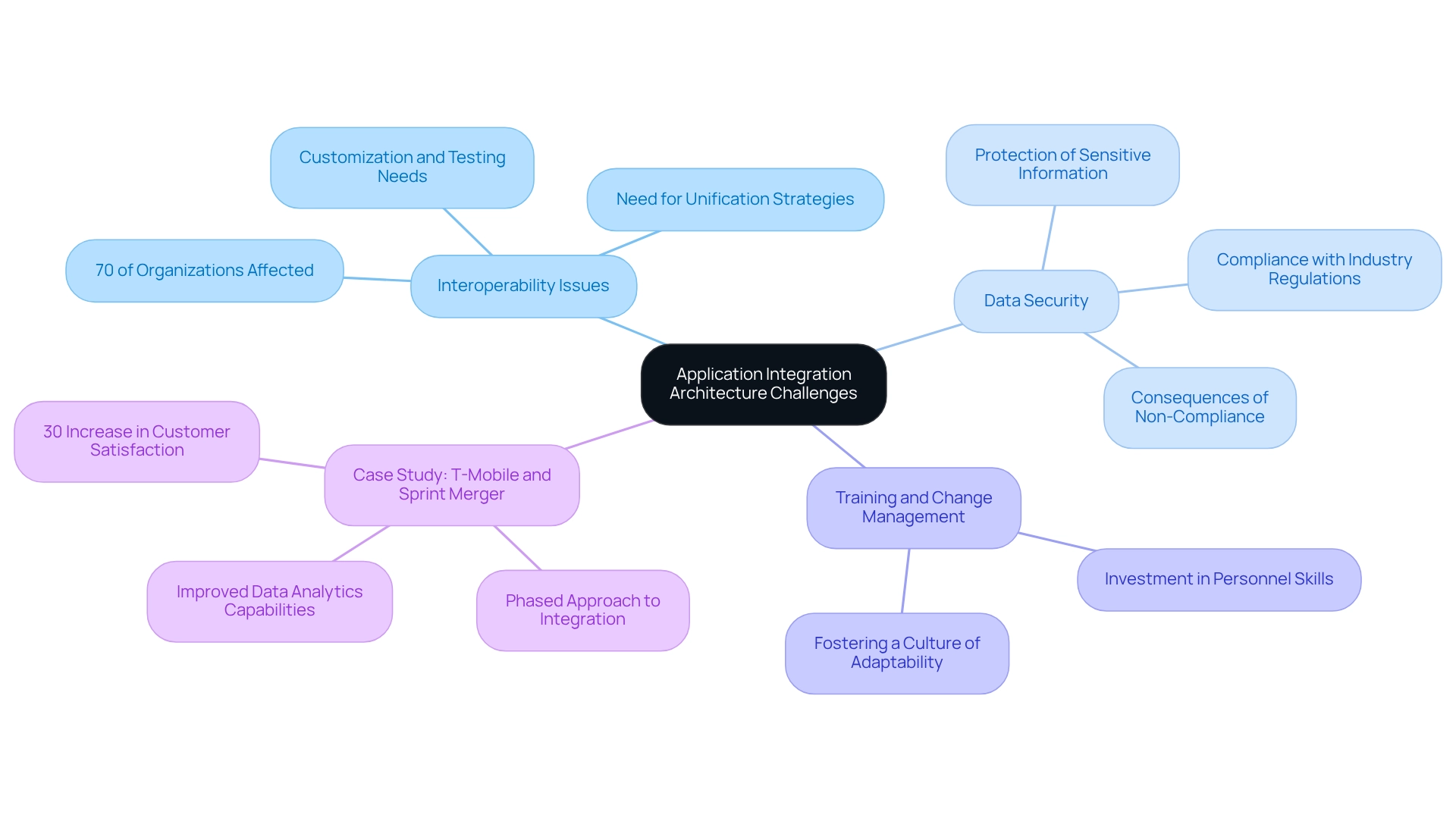Overview
We recognize the critical role that application integration architecture (AIA) plays in modern business. AIA is not just a technical framework; it is the backbone of seamless communication between diverse software applications, driving operational efficiency. By eliminating data silos, we enable real-time insights and improve decision-making. This ultimately leads to significant financial returns and fosters innovation in an ever-evolving digital landscape.
What’s holding your team back from achieving these benefits? With AIA, we can transform your operations, ensuring that every piece of data contributes to your strategic goals. The elimination of data silos alone can revolutionize how your organization functions, providing immediate access to vital information that informs better decisions.
As a result, we invite you to consider the immense value that AIA can bring to your organization. The integration platform is not merely a tool; it is a catalyst for growth and innovation. Let us partner with you to unlock the full potential of your business. Together, we can navigate the complexities of the digital landscape and drive your success forward.
Introduction
In today’s landscape, where digital transformation reigns supreme, the imperative for disparate software applications to communicate effectively has never been more critical. Application Integration Architecture (AIA) stands out as an essential framework that not only enables seamless data exchange but also bolsters operational agility for organizations that depend on multiple systems.
As we observe businesses increasingly acknowledging the strategic benefits of AIA—especially in sectors such as banking and healthcare—the demand for robust integration solutions continues to escalate.
This article explores the significance of AIA, delving into its core components, the challenges encountered during implementation, and how innovative platforms like Avato are redefining the application integration landscape.
By grasping the intricacies of AIA, we empower organizations to navigate their digital journeys more effectively and unlock the full potential of their technology investments.
Define Application Integration Architecture
The architecture for application integration serves as a vital framework that enables seamless communication and information exchange among diverse software applications. By employing a variety of unification techniques and technologies, we ensure the smooth flow of information, which is essential for applications to function cohesively. For organizations reliant on multiple systems, the architecture for application integration (AIA) is indispensable; it effectively eliminates data silos and significantly enhances operational agility.
As we look ahead to 2025, the widespread adoption of architecture for application integration is anticipated, with a substantial percentage of businesses recognizing its value in modern operations. Notably, North America emerged as the largest region in the application unification market in 2024, underscoring the increasing significance of architecture for application integration (AIA) in the sector. The evolving landscape of software architecture, driven by advancements in AI and machine learning, underscores the necessity for robust connection frameworks. Additionally, the rise of Open Banking initiatives has intensified the demand for secure, API-driven connection solutions, making architecture for application integration even more relevant, particularly in the banking sector.
Our hybrid unification platform at Avato exemplifies how organizations can enhance and extend the value of their legacy technologies while streamlining complex connections. With the ability to access data and networks in weeks rather than months, we empower companies to future-proof their operations through seamless data and network connectivity. Furthermore, our platform provides real-time oversight and notifications regarding system performance, significantly reducing costs associated with implementation. Successful applications of the architecture for application integration frameworks are evidenced by case studies such as the integration of Salesforce with QuickBooks Online. This unification allows companies to synchronize customer information, sales orders, and invoices in real time, simplifying accounting processes and enhancing data accuracy, ultimately improving customer service. As Gustavo Estrada aptly noted, ‘Avato has the capability to streamline intricate projects and produce outcomes within established timelines and financial limits,’ reinforcing the efficiency of architecture for application integration frameworks in achieving objectives.
The importance of structured frameworks in the architecture for application integration cannot be overstated. They offer a blueprint that not only modernizes technology landscapes but also protects the integrity and security of data. As we continue to navigate the complexities of digital transformation, the architecture for application integration provided by AIA stands out as a foundational element that supports our integration goals and operational efficiency.

Explain the Importance of Application Integration Architecture in Business
The significance of architecture for application integration in contemporary business is paramount. In a progressively digital landscape, we face the challenge of integrating various applications and platforms to ensure seamless operations. AIA serves as a critical framework that embodies architecture for application integration, facilitating effective communication among diverse systems and resulting in enhanced information accuracy and reduced operational expenses.
Statistics indicate that enterprises investing in architecture for application integration (AIA) can expect an impressive 100-fold return, underscoring the financial advantages of architecture for application integration. Moreover, architecture for application integration enhances our decision-making capabilities by providing timely and precise data, which is essential for data-driven strategies. By streamlining processes and enabling real-time insights, we can respond swiftly to market changes and customer needs.
A case study titled ‘Application Connection Architecture‘ demonstrates that meticulous planning and design of architecture for application integration yield significant business advantages, such as increased efficiency and agility. As we strive to innovate, the architecture for application integration becomes crucial in facilitating rapid adaptation to new technologies without disrupting existing workflows. This adaptability not only fosters innovation but also helps us maintain a competitive edge across various sectors, including banking and healthcare.
At Avato, we play a pivotal role in this process, assisting organizations in leveraging AIA to enhance their operational capabilities. By focusing on harnessing generative AI, we empower financial institutions to elevate customer experience through sophisticated chatbots and virtual assistants, while also streamlining document processing and report generation. The ability to connect legacy infrastructures with contemporary applications further amplifies the significance of architecture for application integration, making it an essential element of any effective digital transformation strategy.
As noted by Gustavo Estrada, Avato simplifies complex projects and delivers results within desired time frames and budget constraints, showcasing the effectiveness of AIA in real-world applications. Additionally, as Tony LeBlanc from the Provincial Health Services Authority states, ‘Good team. Good people to work with. Extremely professional. Extremely knowledgeable.’ This testimonial highlights our dedication to excellence in unification solutions.
Furthermore, recent statistics reveal a 60% increase in the utilization of generative AI for customer experience, which highlights the critical role of architecture for application integration (AIA) in the financial sector. By integrating these elements, we can better position ourselves for success in a rapidly evolving landscape.

Identify Key Components and Characteristics of Application Integration Architecture
Key elements of architecture for application integration are critical for modern businesses. Middleware, application programming interfaces (APIs), information integration tools, and messaging systems form the architecture for application integration (AIA), facilitating seamless communication between diverse applications while ensuring precise and secure information transfer.
- Middleware is essential for this, while APIs enable real-time information exchange and shared functionalities, which are indispensable in today’s fast-paced business environment.
- Data unification tools consolidate information from various sources, enhancing data accessibility and usability.
- Furthermore, messaging frameworks guarantee dependable message transmission between applications, further enhancing operations.
Effective architecture for application integration is characterized by scalability, flexibility, and security—qualities that are vital for adapting to changing business needs and protecting sensitive information.
As the global application unification market continues to grow, driven by the increasing demand for business process enhancement and real-time communication between platforms, we recognize the importance of architecture for application integration in establishing robust unification strategies. This growth underscores the need for solutions such as Avato, which guarantees 24/7 uptime for essential connections, enabling businesses to innovate without disruption.
For instance, successful cases of enterprise application connectivity (EAI) involve linking Customer Relationship Management (CRM) and Enterprise Resource Planning (ERP) frameworks, providing real-time access to inventory information, as well as connecting Human Resource Management (HRM) solutions with payroll applications—connections that Avato simplifies through its advanced architecture for application integration.
Looking ahead to 2025, we anticipate a heightened focus on middleware and APIs within architecture for application integration, with statistics indicating that a significant portion of organizations will rely on these technologies to enhance their connectivity capabilities. Extensive logging capabilities are becoming increasingly important, aiding in troubleshooting and performance evaluation of connection systems.
Avato’s platform offers these extensive logging features, ensuring that organizations can effectively monitor and enhance their connections. Additionally, by leveraging XSLT within Avato’s solutions, we facilitate efficient XML data transformation, significantly reducing programming errors and associated costs through the use of schemas.
Moreover, Avato’s platform enhances and prolongs the value of legacy frameworks, streamlining intricate connections and lowering expenses. As organizations like BC Provincial Health Services Authority have experienced, leveraging effective architecture for application integration can simplify complex projects and deliver results within desired time frames and budget constraints, as noted by customer Gustavo Estrada:
‘Avato’s architecture for application integration has simplified complex projects and delivered results within desired time frames and budget constraints.

Discuss Challenges and Considerations in Implementing Application Integration Architecture
Implementing architecture for application integration presents a significant challenge that can profoundly influence our efforts in digital transformation. Ensuring interoperability between legacy technologies and modern applications is a primary concern, often requiring extensive customization and rigorous testing. Nearly 70% of organizations encounter interoperability issues with their legacy systems, highlighting the urgent need for effective unification strategies. Our hybrid connection platform addresses these challenges by facilitating seamless information connectivity, which is integral to the architecture for application integration and bridging the gap between isolated assets. By mobilizing stakeholders and leveraging the right technology, we can accurately depict our current and desired states, ensuring that our coordination efforts align with business objectives.
Data security is another critical factor, especially when sensitive information is shared across various platforms. We must implement robust security measures to protect information integrity and comply with industry regulations, as non-compliance can lead to severe penalties. This necessity is particularly pronounced in sectors like banking and healthcare, where information breaches can have dire consequences.
Moreover, effective implementation requires investment in training and change management to equip our personnel with the essential skills to navigate new technologies. This investment fosters a culture of adaptability and ensures that our employees can effectively utilize collaborative tools.
A notable case study illustrating these challenges is the merger of T-Mobile and Sprint in 2020, which necessitated the unification of their distinct customer relationship management (CRM) platforms. By adopting a phased approach, they successfully integrated their systems within a year, enhancing data analytics capabilities and improving customer satisfaction by up to 30%. This scenario underscores the critical importance of strategic planning and execution in overcoming unification challenges, especially as the architecture for application integration within the enterprise application unification market is projected to grow at a compound annual growth rate (CAGR) of 15.65% through 2029, requiring us to proactively address these challenges to enhance our unification efforts and achieve our digital transformation objectives. Our commitment to pioneering hybrid integration solutions positions us as a key partner in helping businesses future-proof their operations, ensuring they remain competitive in the evolving digital landscape.

Conclusion
The exploration of Application Integration Architecture (AIA) reveals its indispensable role in modern business operations. By facilitating seamless communication and data exchange among diverse applications, we enhance operational agility and eliminate data silos, thereby fostering improved efficiency and accuracy. As we recognize the strategic advantages of AIA, particularly in sectors like banking and healthcare, the adoption of robust integration solutions becomes imperative for navigating the complexities of digital transformation.
Key components such as middleware, APIs, and data integration tools are vital in creating a flexible and secure integration environment. The significance of these elements is underscored by the challenges we face, including interoperability issues with legacy systems and the critical need for data security. Successful implementation of AIA requires careful planning, investment in training, and a commitment to change management, as illustrated by real-world case studies demonstrating its impact on enhancing operational capabilities.
Ultimately, AIA stands as a foundational element for any organization seeking to thrive in a rapidly evolving digital landscape. By leveraging innovative platforms like Avato, we can simplify complex integrations, maximize the value of our existing systems, and position ourselves strategically for future growth. Embracing AIA not only unlocks the full potential of our technology investments but also empowers us to adapt swiftly to market changes and customer needs, solidifying our competitive edge in today’s dynamic environment.

